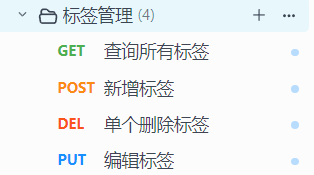- A+
个人博客-给文章添加上标签
优化计划
本篇文章实现文章标签功能
思路
首先需要新增一个标签类Tag,然后Post文章类和Tag标签类的关系是多对多的关系。也就是一个文章可以有多个标签,一个标签也可以被多个文章使用。
为了实现这个多对多关系,光有Tag表和Post表还不够,还需要一个中间表去维护标签和文章之间的关联关系,就定为PostTag表吧。
代码实现
准备工作
为Post类新增导航属性
public List<Tag> Tags { get; set; } 新增Tag类
public class Tag { /// <summary> /// 标签ID /// </summary> [Key] //主键 public int Id { get; set; } /// <summary> /// 标签名称 /// </summary> public string Name { get; set; } /// <summary> /// 导航属性 - 文章列表 /// </summary> public List<Post>? Posts { get; set; } } 新增PostTag类
public class PostTag { /// <summary> /// 标签ID /// </summary> public int TagId { get; set; } /// <summary> /// 导航属性 - 文章 /// </summary> public Post Post { get; set; } /// <summary> /// 导航属性 - 标签 /// </summary> public Tag Tag { get; set; } } 在DbContext数据库上下文中添加新增类
public DbSet<Tag> Tags { get; set; } public DbSet<PostTag> PostTags { get; set; } 然后是上下文的protected override void OnModelCreating(ModelBuilder modelBuilder)方法中添加
modelBuilder.Entity<Post>() .HasMany(e => e.Tags) .WithMany(e => e.Posts) .UsingEntity<PostTag>(); 类创建完成后,需要在数据库中新增Tags表和PostTags表,使用Code First模式或者手动创建都行。
控制器
修改之前打包上传文章的控制器,新增List
public async Task<ApiResponse<Post>> Upload([FromForm] String Categoryname,[FromForm]String Parent, [FromForm] List<string> tags,IFormFile file,[FromServices] ICategoryService categoryService ) 服务
在之前的打包上传服务新增标签处理
public async Task<Post> Upload(int CategoryId, List<string> tags,IFormFile file){ ....之前的代码 foreach (var tagName in tags) { var tag = await _myDbContext.Tags.FirstOrDefaultAsync(t => t.Name == tagName); if (tag == null) { tag = new Tag { Name = tagName }; _myDbContext.Tags.Add(tag); } var postTag = new PostTag { Post = post, Tag = tag }; _myDbContext.PostTags.Add(postTag); } await _myDbContext.SaveChangesAsync(); return post; } 接口测试
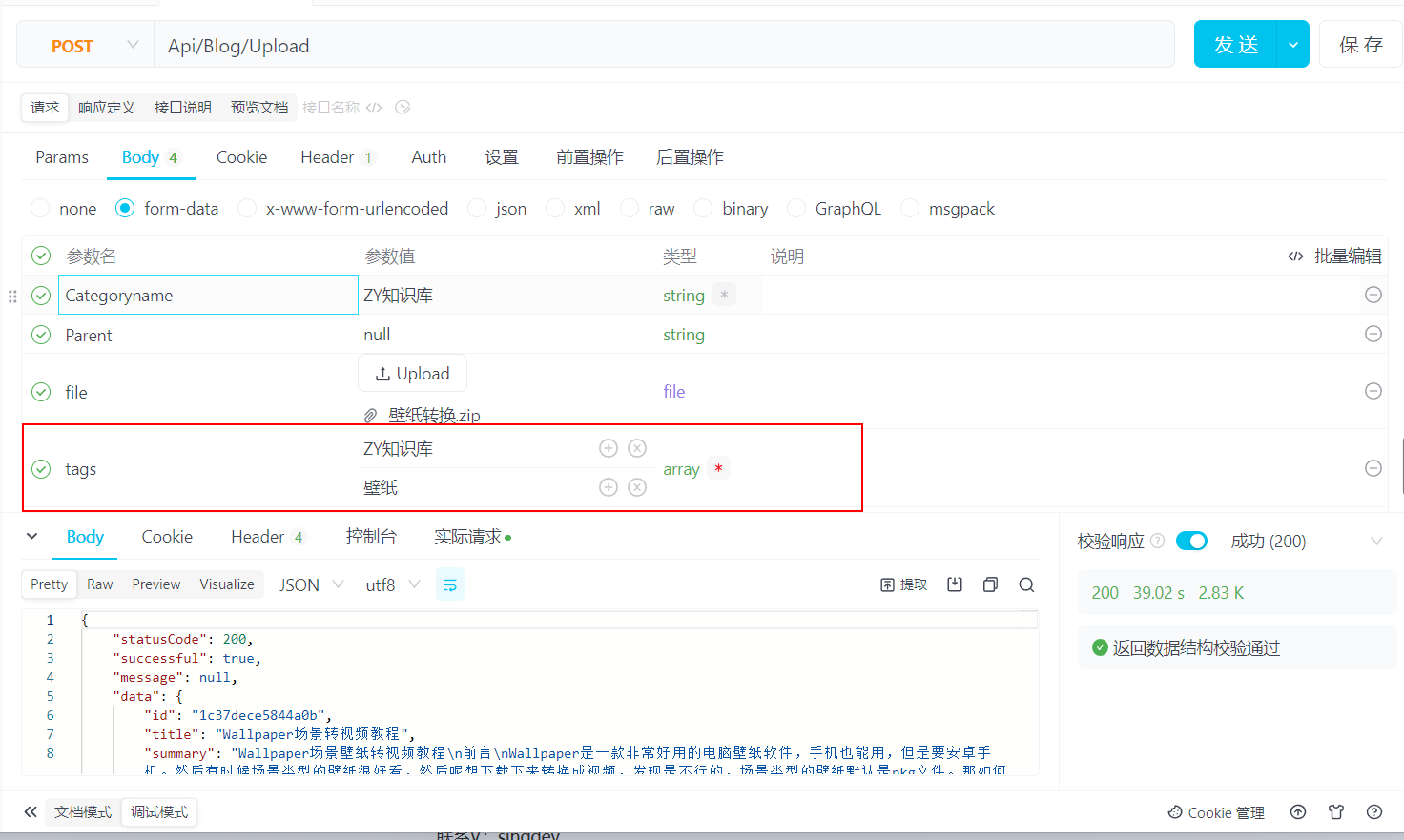
可以看到tags是一个数组类型的参数
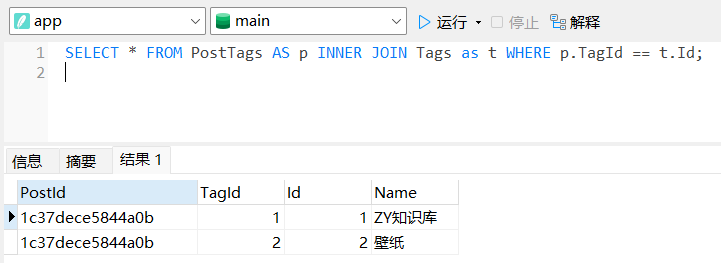
数据库也是添加成功了
Razor页面
上述只是简单的在上传文章的时候设置了一下标签,接下来设计一下页面显示
分页查询服务
首先是分页查询服务,可以看到是返回的一个元组,然后PaginationMetadata是分页数据,之前在做推荐博客加载的时候提过一下,之前是没有用到的,然后现在是用到了,所以需要计算一下分页的信息。顺便提一下这个类是大佬的一个Nuget包,然后是提供了ApiResponsePaged类去把元组和数据类结合在一起,在博客的评论中就用到了ApiResponsePaged类来返回数据给前端。但考虑的标签页的设计,就没用这个类,而是直接使用元组,我发现元组用着也不错。
public async Task<(List<PostTag>, PaginationMetadata)> GetAllTagPostAsync(QueryParameters param) { var postTags = await _myDbContext.PostTags .Where(p => p.TagId == param.TagId) .Include(p => p.Post) .ThenInclude(p => p.Categories) .Include(p => p.Post) .ThenInclude(p => p.Comments) .Include(p => p.Post) .ThenInclude(p => p.Tags) .Skip((param.Page - 1) * param.PageSize) .Take(param.PageSize) .ToListAsync(); var totalCount = await _myDbContext.PostTags.CountAsync(p => p.TagId == param.TagId); var pageCount = (int)Math.Ceiling((double)totalCount / param.PageSize); var pagination = new PaginationMetadata() { PageNumber = param.Page, PageSize = param.PageSize, TotalItemCount = totalCount, PageCount = pageCount, HasPreviousPage = param.Page > 1, HasNextPage = param.Page < pageCount, IsFirstPage = param.Page == 1, IsLastPage = param.Page == pageCount, FirstItemOnPage = (param.Page - 1) * param.PageSize + 1, LastItemOnPage = Math.Min(param.Page * param.PageSize, totalCount) }; return (postTags, pagination); } 控制器
public async Task<IActionResult> Index(int tagId = 1, int page = 1, int pageSize = 8) { var TagList = await _tagService.GetAllTagAsync(); if (TagList.Count == 0) return View(new TagIndex() { TagList = await _tagService.GetAllTagAsync(), TagId = 0, TagAllPosts = await _tagService.GetAllTagPostAsync( new QueryParameters { Page = page, PageSize = pageSize, TagId = tagId, }) }); var currentTag = tagId == 1 ? TagList[0] :await _tagService.GetById(tagId); if (currentTag == null) { _messages.Error($"标签 {currentTag} 不存在!"); return RedirectToAction(nameof(Index)); } TagIndex tagIndex = new TagIndex() { TagList = await _tagService.GetAllTagAsync(), TagId = currentTag.Id, TagAllPosts = await _tagService.GetAllTagPostAsync( new QueryParameters { Page = page, PageSize = pageSize, TagId = currentTag.Id, }) }; return View(tagIndex); } 分页组件
@model (Personalblog.Model.ViewModels.Categories.PaginationMetadata,int) <nav aria-label="Page navigation"> <ul class="pagination justify-content-center"> <li class="page-item @(!Model.Item1.HasPreviousPage ? "disabled" : "")"> <a class="page-link" href="#" aria-label="Previous" href="@Url.Action("Index", new { tagId = Model.Item2, page = Model.Item1.PageNumber - 1, pageSize = Model.Item1.PageSize })"> <span aria-hidden="true">«</span> <span class="sr-only">Previous</span> </a> </li> @for (int i = 1; i <= Model.Item1.PageCount; i++) { <li class="page-item @(Model.Item1.PageNumber == i ? "active" : "")"> <a class="page-link" href="@Url.Action("Index", new { tagId = Model.Item2, page = i, pageSize = Model.Item1.PageSize })">@i</a> </li> } <li class="page-item @(!Model.Item1.HasNextPage ? "disabled" : "")"> <a class="page-link" href="#" aria-label="Next" href="@Url.Action("Index", new { tagId = Model.Item2, page = Model.Item1.PageNumber + 1, pageSize = Model.Item1.PageSize })"> <span aria-hidden="true">»</span> <span class="sr-only">Next</span> </a> </li> </ul> </nav> Tag文章组件
@using Personalblog.Migrate @model List<Personalblog.Model.Entitys.PostTag> @foreach (var p in Model) { <div class="col-md-3 col-12 mb-2"> <div class="card" style="padding:0;"> <img class="bd-placeholder-img card-img-top" alt="" src="@Url.Action("GetRandomImage", "PicLib", new { seed = p.PostId, Width = 800, Height = 1000 })"> <div class="card-body"> <h5 class="card-title">@p.Post.Title</h5> <p class="card-text">@p.Post.Summary.Limit(50)</p> <div class="mb-1 text-muted d-flex align-items-center"> <span class="me-2">@p.Post.LastUpdateTime.ToShortDateString()</span> <div class="d-flex align-items-center"> <i class="bi bi-eye bi-sm me-1"></i> <span style="font-size: 0.875rem;">@p.Post.ViewCount</span> </div> <span style="width: 10px;"></span> <!-- 这里设置了一个 10px 的间距 --> <div class="d-flex align-items-center"> <i class="bi bi-chat-square-dots bi-sm me-1"></i> <span style="font-size: 0.875rem;">@p.Post.Comments.Count</span> </div> </div> </div> <ul class="list-group list-group-flush"> <li class="list-group-item"> <div class="row"> @await Html.PartialAsync("Widgets/Tags", p.Post.Tags) </div> </li> </ul> <div class="card-body"> <a asp-controller="Blog" asp-action="Post" asp-route-id="@p.Post.Id"> Continue reading </a> </div> </div> </div> } Tag主页面
@model Personalblog.Model.ViewModels.Tag.TagIndex @{ ViewData["Title"] = "标签页"; } @section head { <link href="~/lib/Tag/Tag.css" rel="stylesheet"> } <div class="container px-4 py-3"> <h2 class="d-flex w-100 justify-content-between pb-2 mb-3 border-bottom"> <div>Tag</div> <div>文章标签</div> </h2> <div class="row mb-4"> @await Html.PartialAsync("Widegets/TagPostCard",Model.TagAllPosts.Item1) //文章 </div> @await Html.PartialAsync("Widegets/TagPagination",(Model.TagAllPosts.Item2,Model.TagId))//分页 </div> 我在调用分部视图的时候,元组的好处就体现出来了,将数据和分页分开去写页面,分页视图我就传递item2也就是PaginationMetadata类,文章页面我就传递item1也就是文章数据。
效果展示

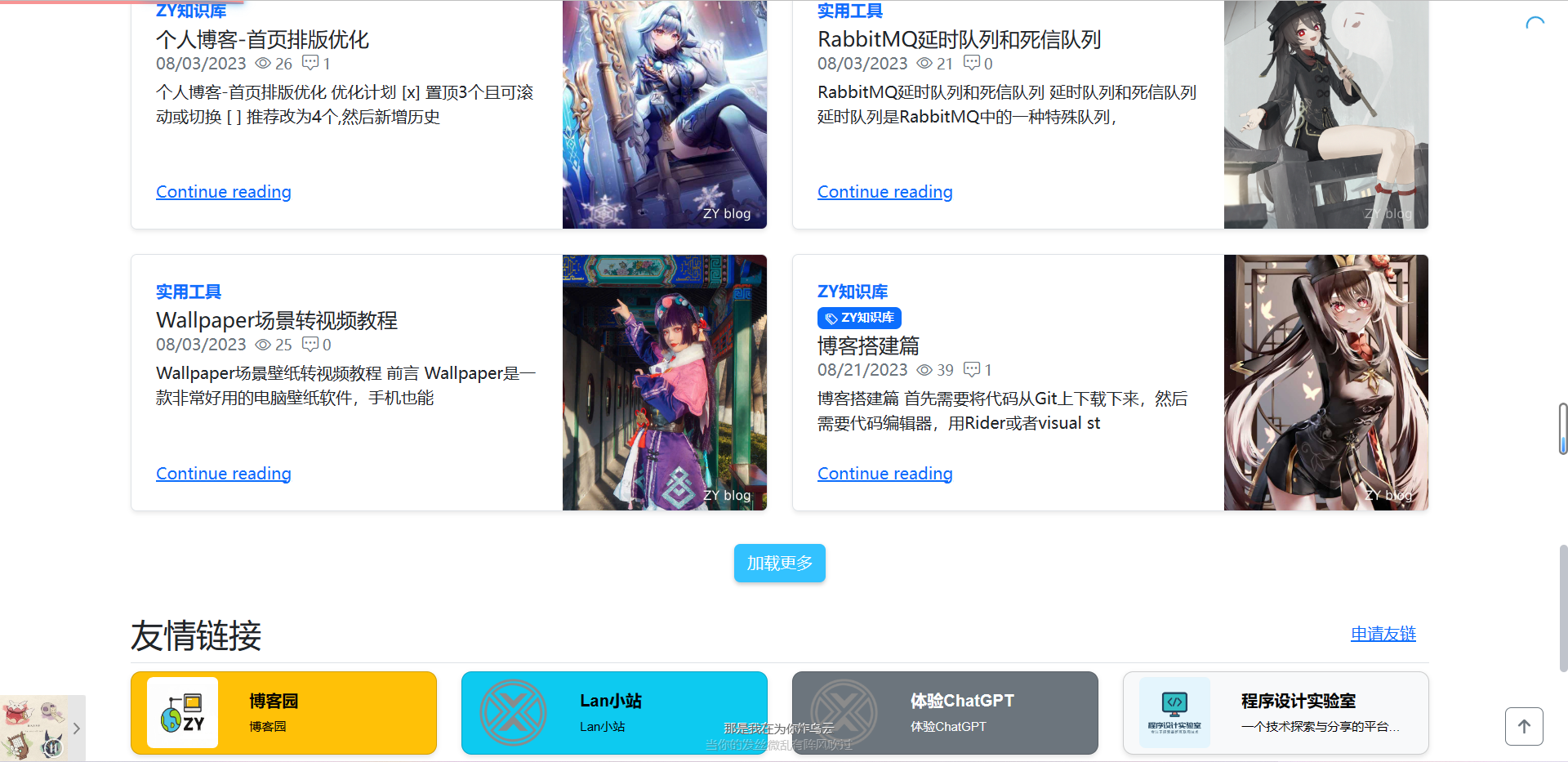
很多文章我还没来得及添加标签,问题不大,文章编辑标签的接口也是写了的~
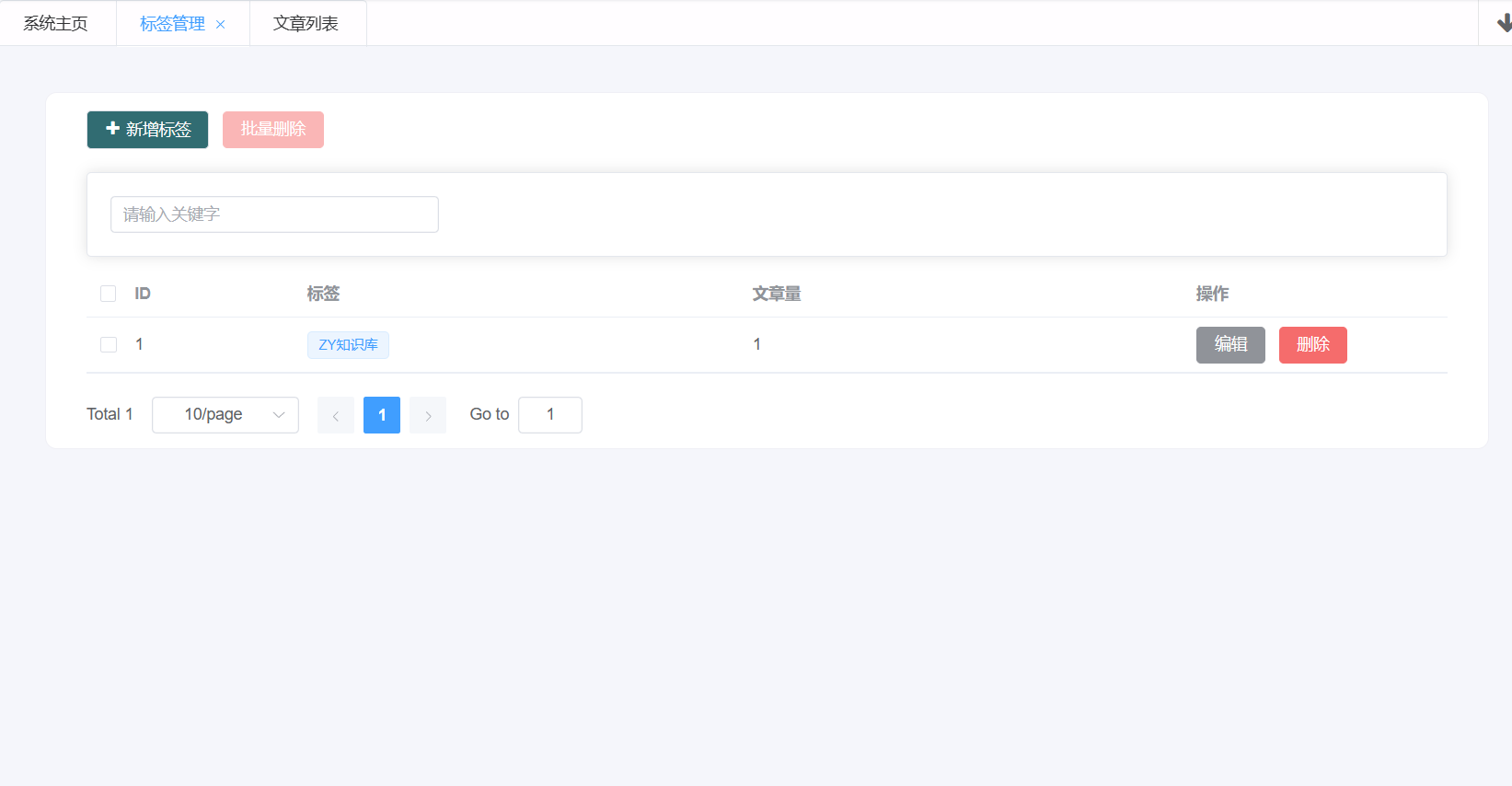
参考资料
可以去看看官方文档的多对多关系的解释
- 多对多关系 - EF Core | Microsoft Learn https://learn.microsoft.com/zh-cn/ef/core/modeling/relationships/many-to-many
结尾
页面就简单的做完了,然后后台的接口就是一些简单的crud,这里就不细讲了。主要看多对多关系和元组这2个好东西就行了~
